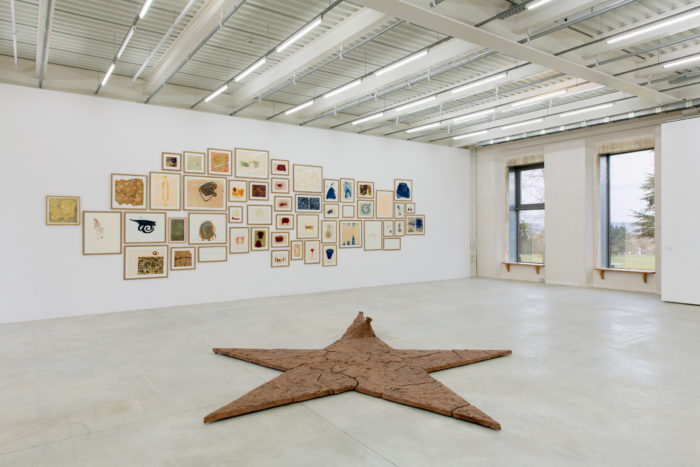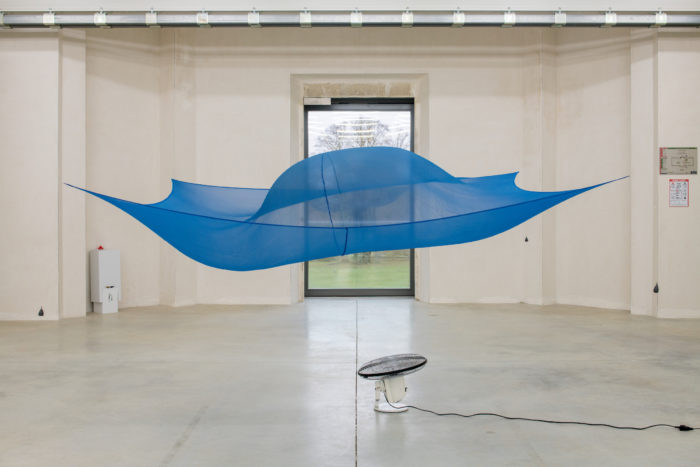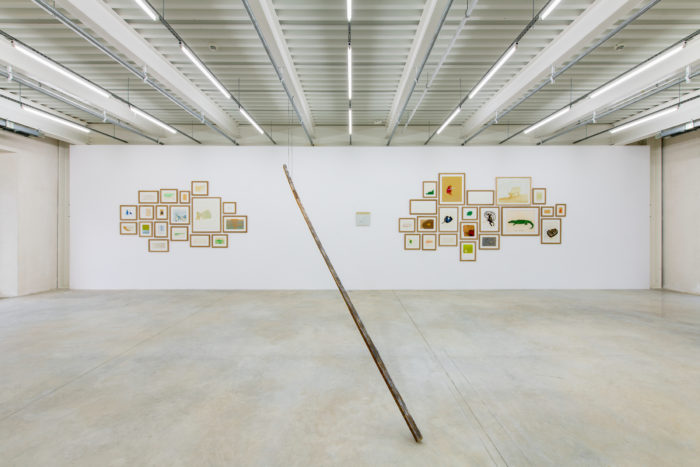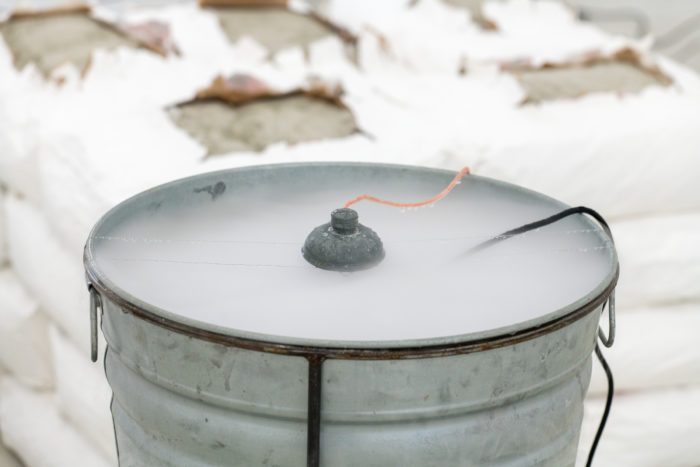Opening on Sunday 11 March, from 3pm to 5:30pm
Exhibition curator : Keren Detton
Works from the collection of the Frac Grand Large – Hauts-de-France
With : Carl Andre, John Armleder, Micol Assaël, Robert Barry, Joseph Beuys, Jean-Sylvain Bieth, Pier Paolo Calzolari, Nina Canell, Julien Creuzet, Christine Deknuydt, Nicolas Deshayes, Matias Faldbakken, Robert Filliou, Gloria Friedmann, Hans Haacke, Peter Joseph, Jannis Kounellis, Dennis Oppenheim, Lisa Oppenheim, Emmanuel Pereire, Evariste Richer, Jean-Luc Verna, Jacques Villeglé, Franz West, Gilberto Zorio
Le Paradoxe de l’iceberg (The Paradox of the Iceberg) exhibition at the Château de Rentilly brings together works from the Frac Grand Large – Hauts-de-France collection that use raw materials subjected to chemical or physical modifications. These materials are chosen for their aesthetic properties, as well as their energy or symbolic charge. Signs and traces are combined in the exhibition, those stemming from searching for a visual language in pursuit of its own physical and metaphysical limits. The artists share their doubts about what is and what could happen. From chemistry of the elements to cosmic representations, many works from the Frac Grand Large collection blend literary and poetic endeavours to find another side, to delve beneath the surface and capture the elusive.
Matter is never what it seems.
The exhibition is inspired by the work of Christine Deknuydt (1967-2000). As the Frac Grand Large has received a donation of her works in 2018 we have chosen to shed light on her practice. During her short career, this artist from the North laid the groundwork for extremely diverse graphic and pictorial research, open to the unexpected effects of words and materials. Like in a chemistry laboratory, the artist blended components testing the results on recycled media. In parallel, she established a vocabulary of ambiguous figures and in some instances supported by terse comments. The forms are endlessly repeated but always in different ways, often diluted and blurred by their treatment. Christine Deknuydt thus emphasises porosity between subjects, texts and textures.
One of her watercolours in a dazzling blue wash gave the exhibition its title: ‘Le Paradoxe de l’iceberg’. It comprises two lines of mirror-inverted peaks. The iceberg shape, often visible in her work, shifts our attention to what is hidden. Indeed, the tip only forms a small portion, barely 10% of the total volume. This form encourages other dimensions of space to be considered, beyond what is visible. Furthermore, the iceberg also conveys the phenomenon of global warming and the gradual disappearance of sea ice. Is depicting the iceberg another way of capturing time and the vagaries of transformation?
The exhibition brings together twenty-five international artists, taking shape by examining Christine Deknuydt’s fictitious apprenticeship with different explorers of the palpable world. A selection of works close to minimalism (Carl Andre, Peter Joseph, Hans Haacke) focuses on those where the formal rigour opens itself to the mercy of the elements: wood, pigments and wind. They mirror experiments on states of matter initiated by Arte Povera (Pier Paolo Calzolari, Gilberto Zorio, Nina Canell) and materials that conduct energy (Micol Assaël).
Some artists seek to capture the intensity of the moment (Dennis Oppenheim, Lisa Oppenheim, Evariste Richer). Others favour movement and fluidity. Their works appear to encapsulate the proclamation of a future (Nicolas Deshayes, Emmanuel Pereire). Joseph Beuys, Jean-Sylvain Bieth, Jannis Kounellis and Gloria Friedmann link presentation of materials and symbolic representation.
Similar to Robert Filliou who promotes equivalence between well done, badly done and not done, Christine Deknuydt identifies with ‘permanent Creation’ and experiments with transcending contradictions. Thereby, oils and toxic substances that enrich her palette also attack their media and pose a danger to them. Artists John Armleder, Matias Faldbakken, Jacques Villeglé and Franz West question the value of works themselves also using remnants or crude materials. Robert Barry’s primary material is language. As for Jean-Luc Verna and Julien Creuzet, at the heart of the materials they evoke narratives of the body and its social and political condition.
Many contemporary artists claim their affiliation with artistic movements in the 1960s-70s: Arte Povera, land art, minimalism, new realism and Fluxus, each with their own take on the materiality of art. Le Paradoxe de l’iceberg exhibition aims to blend generations and show different relationships with material nurtured by historic, scientific, literary or spiritual approaches. Solicited directly, visually and sensitively, visitors are invited to observe, between detachment and speculation, seeking a variety of interpretations.
The Frac Grand Large – Hauts de France
France’s Fonds Régionaux d’Art Contemporain (Regional Contemporary Art Collections/FRACs) make up a network of 23 public collections all over France, including two in the Hauts-de-France administrative region. The FRACs are tasked with creating and promoting collections of contemporary art and organising temporary exhibitions, discussion events, publications and awareness and education campaigns throughout their specific territories.
Frac Grand Large–Hauts-de-France has built up its collection around an initial nucleus of Arte Povera, Minimalist and Conceptual works in a variety of media including painting, photography and installation. It is also home to a design collection testifying to its receptiveness to everyday objects with a truly international mix of sources and exhibits. Extending from the 1960s up to the present day, this remarkable array of works is the keystone of its programming on-site and in the Region.
Designed by the architects Lacaton & Vassal and looking out to the horizon beyond Dunkirk harbour, Frac Grand Large–Hauts-de-France is remarkable both as an exhibition venue and an exercise in conservation: the building is a see-through replica of the old AP2 prefabrication workshop, a historic part of the city’s shipbuilding past.
frac île-de-france, le château
Parc culturel de Rentilly – Michel Chartier
Domaine de Rentilly
1 rue de l’Etang
77600 Bussy-Saint-Martin
fraciledefrance.com / parcculturelrentilly.fr
Free entrance
Wed. & Sat. 2:30pm – 5:30pm
Sun. 10:30am – 1pm, 2:30pm – 5:30pm
rendez-vous
TaxiTram
Saturday 07.07.18
at frac île-de-france, le plateau and le château + Maison d’Art Bernard Anthonioz
RSVP : 01 53 34 64 43 – taxitram@tram-idf.fr
Guide tour
Each Sunday – 3pm




